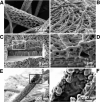Conducting-Polymer Nanotubes for Controlled Drug Release
- PMID: 21552389
- PMCID: PMC3088882
- DOI: 10.1002/adma.200501726
Conducting-Polymer Nanotubes for Controlled Drug Release
Figures




References
-
- Devoret MH, Esteve D, Urbina C. Nature. 1992;360:547.
-
- Ozin GA. Adv. Mater. 1992;4:612.
-
- Gref R, Minamitake Y, Peracchia MT, Trubetskoy V, Torchilin V, Langer R. Science. 1994;263:1600. - PubMed
-
- Parthasarathy RV, Martin CR. Nature. 1994;369:298. - PubMed
-
- Whitesides GM, Mathias JP, Seto CT. Science. 1991;254:1312. - PubMed
Grants and funding
LinkOut - more resources
Full Text Sources
Other Literature Sources

